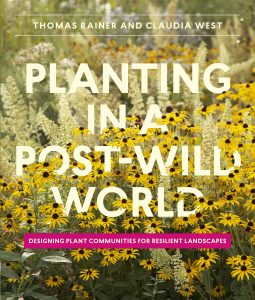Planting in a Post-Wild World
Posted in From the Library on September 12 2016, by Esther Jackson
 Sometimes one comes across a landscape design book that simply demands to be read from cover to cover without pause. Planting in a Post-Wild World is one such book. Part ecological manifesto, part how-to planting guide, and part artistic statement, Post-Wild is a wonderful and refreshing addition to the world of landscape and planting design literature.
Sometimes one comes across a landscape design book that simply demands to be read from cover to cover without pause. Planting in a Post-Wild World is one such book. Part ecological manifesto, part how-to planting guide, and part artistic statement, Post-Wild is a wonderful and refreshing addition to the world of landscape and planting design literature.
Thomas Rainer and Claudia West are co-authors of Post-Wild. Rainer is a registered landscape architect, teacher, and writer, and West is a landscape designer, lecturer, and consultant. Both work in the U.S., but in the evocative preface each writes of the very different beginnings of their understanding of the wild.
For Rainer, the wild existed in his childhood Alabama neighborhood—a shrinking natural area that fell prey to developers as he grew up. For West, the wild she found was in her childhood East Germany of the 1980s. Areas that had been untouched by human hands were relatively scarce, but many previously-industrialized and developed areas fell out of use post-WWII. The wild that crept back was eclectic and beautiful, and after the Berlin Wall fell, nature proved resilient as previously toxic areas were cleaned and restored. The authors write:
We come to this book representing two different continents and two different experiences of nature. The North American perspective still has a memory of wilderness; the European perspective is immersed in an entirely cultured landscape. Thomas [Rainer]’s story is one of nature lost; Claudia [West]’s is one of nature regained. This combined perspective perfectly describes the tension in which nature now exists: its continued disappearance in the wild; its expanded potential in urban and suburban areas.
In many ways, this book reads like a novel. In addition to the Preface and Conclusion, there are five sections. These are titled: “Nature as it was, nature as it could be,” “Principles of designed plant communities,” “The inspiration of the wild,” “The design process,” and “Creating and managing a plant community.” This is already a bit of a departure from similar landscape design books. You won’t find a plant list so much as you’ll find ruminations about different plant communities. The goal is not to imitate natural settings (grasslands, woodlands and shrublands, forests), but rather to draw inspiration from them. “Designed plant communities… need not replicate nature in order to capture its spirit.”
As is often the case with gardening and landscape design books, authors do not shy away from mixing native plants with exotic species. The authors write, “While focusing on naturally occurring plant communities, as opposed to those that are purely native, the focus is shifted from a plant’s country of origin to its performance and adaptability.” (Emphasis by the authors.) While this sounds delightful and even magnanimous on paper, in reality the exotic species that thrive in new sites and settings are often ones that run the danger of becoming invasive. While the philosophy of the authors is understandable, the threat of invasives is not really addressed. Perhaps this is not the nature of the work, but responsible land management is an important area, and so this is worthy of note.
Ultimately, Post-Wild is a fantastic book on many levels. It is thoughtful, engaging, and well-written. The photographs and diagrams are clear and helpful. It is a fine introduction for new landscape designers and gardeners, and may offer inspiration to the experienced professionals as well as the amateurs. I look forward to reading more from both Rainer and West as they continue to design, plant, and philosophize about the wild.

